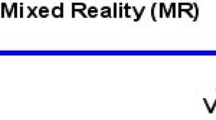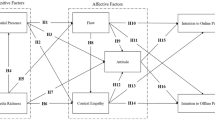Abstract
This research statistically analyzes factors that influence consumer intention to use virtual reality services. The result shows that the main predictors of intention to use virtual reality services, in the order of importance, are hedonic motivation, personal innovativeness, effort expectancy and performance expectancy. And it shows that the higher were the impacts of effort expectancy, social influence, performance expectancy, and hedonic motivation on intention to use the services the higher was a customer’s personal innovativeness. According to the results, marketing strategies for virtual reality services should appeal to consumers by positioning the using experience as an adventure or a way to reduce their stress and change a negative mood. Also they should be reputation-building and target early adopters.
This work was supported by Hankuk University of Foreign Studies Research Fund of 2016.
Access this chapter
Tax calculation will be finalised at checkout
Purchases are for personal use only
Similar content being viewed by others
References
Nguyen, M.-T., Nguyen, H.-K., Vo-Lam, K.-D., Nguyen, X.-G., Tran, M.-T.: Applying virtual reality in city planning. LNCS, vol. 9740, pp. 724–735 (2016)
Almusawi, A., Dülger, L.C., Kapucu, S.: Robotic arm dynamic and simulation with virtual reality model. In: International Conference on CoDIT, pp. 335–340 (2016)
Venkatesh, V., Morris, M., Davis, G., Davis, F.: User acceptance of information technology: toward a unified view. MIS Q. 27(3), 425–478 (2003)
Drennan, J., Mort, G.S., Previte, J.: Privacy, risk perception, and expert online behavior: an exploratory study of household end users. J. Organ. End User Comput. 18, 1–22 (2006)
Hwang, Y.-H., Moon, Y.-J.: Analysis of factors influencing intention to use the online-only bank and interaction effects among the factors. Adv. Sci. Lett. 22(9), 2588–2591 (2016)
Yoon, H.S., Steege, L.M.B.: Development of a quantitative model of the impact of customers’ personality and perceptions on internet banking use. Comput. Hum. Behav. 29, 1133–1141 (2013)
Parameswaran, S., Kishore, R., Li, P.: Within-study measurement invariance of the UTAUT instrument: an assessment with user technology engagement variables. Inf. Manag. 52(3), 317–336 (2015)
Escobar-Rodriguez, T., Carvajal-Trujillo, E.: Online purchasing tickets for low cost carriers: an application of the unified theory of acceptance and use of technology (UTAUT) model. Tour. Manag. 43, 70–88 (2014)
Chin, W.W., Peterson, R.A., Brown, S.P.: Structural equation modeling in marketing: some practical reminders. J. Mark. Theory Pract. 16(4), 287–298 (2008)
Author information
Authors and Affiliations
Corresponding author
Editor information
Editors and Affiliations
Rights and permissions
Copyright information
© 2017 Springer Nature Singapore Pte Ltd.
About this paper
Cite this paper
Hwang, YH., Moon, YJ. (2017). Statistical Analysis of Determinants of Intention to Use Virtual Reality Services and Moderating Effects. In: Park, J., Chen, SC., Raymond Choo, KK. (eds) Advanced Multimedia and Ubiquitous Engineering. FutureTech MUE 2017 2017. Lecture Notes in Electrical Engineering, vol 448. Springer, Singapore. https://doi.org/10.1007/978-981-10-5041-1_66
Download citation
DOI: https://doi.org/10.1007/978-981-10-5041-1_66
Published:
Publisher Name: Springer, Singapore
Print ISBN: 978-981-10-5040-4
Online ISBN: 978-981-10-5041-1
eBook Packages: EngineeringEngineering (R0)




